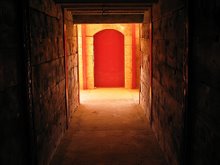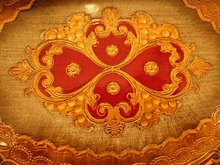After wandering aimlessly for the past two nights around the maze of canals and concentric rings of streets that make up central Amsterdam, I made an executive decision:
 First thing this morning, John and I would find a bike shop and begin our haphazard exploration on wheels. Who knows, maybe before the day was out, we would actually have our bearings. At the very least, we were bound to see more than we would on foot. Two birds. One stone. I call that a good deal.'
First thing this morning, John and I would find a bike shop and begin our haphazard exploration on wheels. Who knows, maybe before the day was out, we would actually have our bearings. At the very least, we were bound to see more than we would on foot. Two birds. One stone. I call that a good deal.'We managed to navigate ourselves to Mac Bike Rentals, just outside Centraal Station, and settled on a pair of seen-better-days black metal bikes, sans handbrakes, each bearing an eyesore of a circular "license plate" with "Mac´s" logo. Opting to save a few euros and skip out on the optional theft insurance, we grimaced at the sight of those logos. They may as well have been flashing neon lights; the message was the same: "I belong to a tourist... STEAL ME!"
 And of we headed into the maze of Amster- dam. We pedaled along the flat canvas of land, trying to adjust to life in the fast lane -- or, the bike lane, at least. Amsterdam is extremely bike-friendly, designating a lane of every major road for two-wheeled travelers. We crisscrossed canals and maneuvered around pedestrians, whizzing past them as if we were born on the back of a bicycle.
And of we headed into the maze of Amster- dam. We pedaled along the flat canvas of land, trying to adjust to life in the fast lane -- or, the bike lane, at least. Amsterdam is extremely bike-friendly, designating a lane of every major road for two-wheeled travelers. We crisscrossed canals and maneuvered around pedestrians, whizzing past them as if we were born on the back of a bicycle.Here and there, we dismounted our black beauties and locked them -- not once, but twice, just for good measure (and rental shop rules) -- before venturing off on foot down one alley or another. It´s no joke that locals often spend more on good locks than they do on their city bikes. Bike theft is rampant, and one look around any canal bridge, bike rack, or lamp post will confirm this to be true. Beat-up bikes are all the fashion in Amsterdam!
Over the course of one rain-splotched day, John and I picnicked on the steps of Dam Square amid a cloud of pesky pigeons, stood at attention before the bronzed status on Rembrandtplein (created in replica of his famous work, "Nightwatch," strolled along the aromatic flower shops of Bloemenmarkt, lined with bushels and baskets of tulips in every color of the rainbow, and wandered through tranquil Beijinhof, a quiet corner of the city set aside as living quarters for nuns and single women.
 We paid a visit to the Anne Frank house, and lingered silently inside the chambers and corridors which were her secret sanctuary for over two years. It has been nearly two decades since I first read her story, read of this young 13-year-old forced to hide in captivity with her family in the empty space above her father´s busy warehouse. It was Nazi Germany, and the Franks, a family with a strong Jewish tradition, were well aware of the Anti-Semitic movement which was growing in intensity with each passing day. Otto Frank, Anne´s father and successful business owner, arranged with two of his trusted colleagues -- his bookkeepers and good friends, for the movement of his family to the hidden quarters above the warehouse.
We paid a visit to the Anne Frank house, and lingered silently inside the chambers and corridors which were her secret sanctuary for over two years. It has been nearly two decades since I first read her story, read of this young 13-year-old forced to hide in captivity with her family in the empty space above her father´s busy warehouse. It was Nazi Germany, and the Franks, a family with a strong Jewish tradition, were well aware of the Anti-Semitic movement which was growing in intensity with each passing day. Otto Frank, Anne´s father and successful business owner, arranged with two of his trusted colleagues -- his bookkeepers and good friends, for the movement of his family to the hidden quarters above the warehouse.I slid behind the moveable bookcase to the hidden hallway leading upstairs, where the Frank family lived for so many months. I walked through Anne´s room, decorated just as she left it, with pasted prints from her celebrity magazines, which Miep Gies would sneak to her on occasion. I viewed the meager water closet and porcelain sink which could olnly be used during certain times of the day, lest the workers below hear water trickling overhead and give their secret up. I peered out the window where Anne watched with guilt at her own safety as a Jewish man was dragged away by the Gestapo. And then, the secret leaked, and one day the Gestapo came for Anne and her family, as well.
 It was heart- breaking to be reminded that Anne and her sister perished in Dachau from typhus, just a few short weeks before the Nazi regime came to a screeching halt. And heartbreaking that Otto Frank was the lone survivor of his family -- God only knows how long he held onto hope that his daughters, his wife, would return to him. But Anneäs diary found its way to him, thanks to the protective care of Miep, who rescued it from Anneäs quarters before the Gestapo had a chance to cart it away with the rest of the family´s meager belongings.
It was heart- breaking to be reminded that Anne and her sister perished in Dachau from typhus, just a few short weeks before the Nazi regime came to a screeching halt. And heartbreaking that Otto Frank was the lone survivor of his family -- God only knows how long he held onto hope that his daughters, his wife, would return to him. But Anneäs diary found its way to him, thanks to the protective care of Miep, who rescued it from Anneäs quarters before the Gestapo had a chance to cart it away with the rest of the family´s meager belongings.As so, a part of Anne survived the camp, and still lives on. Her greatest dream, of becoming a famous author, was fulfilled -- just not in the way she had imagined. But millions have been touched by her honest recounting of a teenage girl hidden away while the world outside began to fall apart. In her childlike, yet wise-beyond-her-years way, her words have worked their way into the hearts of countless people, hungry for an understanding of this black period of humanity.
Back in the daylight again, John and I contemplated the heaviness of Anne´s story from a park bench, while a raging wind surged around us. We capped off our day with a bike ride through Vondelpark, where we shared a scenic, circular bike path with commuters on their way home from the office, making that one last mobile call while steering their bikes with one hand.
~Melanie









No comments:
Post a Comment